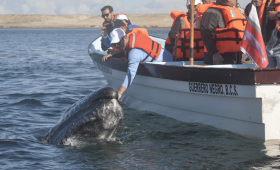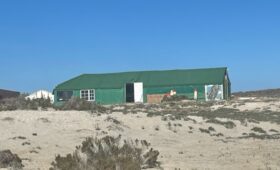As the sun rises over the tranquil waters of Baja California Sur, a subtle ripple breaks the surface. It's not a wave, nor a gust of wind—it's a grey whale surfacing for a breath. This gentle giant, having traveled thousands of miles from the cold, nutrient-rich waters of the Arctic, now finds itself in one of the most peaceful and life- affirming places on Earth: Laguna Ojo de Liebre in Baja California.
For the Eastern North Pacific grey whale (Eschrichtius robustus), this journey is a well-worn path etched in time. Spanning over 10,000 miles round-trip, it’s one of the longest migrations in the animal kingdom. These whales arrive in Baja’s sheltered waters each winter, not to feed, but to rest, mate, and give birth. Let’s follow one particular grey whale—whom we’ll affectionately call “Luna”—through a typical day in her Baja sanctuary.
6:00 AM – Dawn Breaks Over San Ignacio Lagoon
The sky glows in soft pastels as the first light hits the calm waters of San Ignacio Lagoon, one of the key birthing and nursing sites for grey whales in Baja. Luna, a 40-foot-long adult female, floats near the surface with her newborn calf tucked close by. Her thick, barnacle-speckled skin glistens under the warming sun.
Her breathing is slow and rhythmic. Every few minutes, she breaks the surface, releasing a misty spout of air. Luna’s calf mimics her movements, still getting the hang of breathing, swimming, and navigating the world. Born just a few weeks ago in these very waters, the calf is already over 15 feet long and growing rapidly, thanks to Luna’s nutrient-rich milk.
8:00 AM – Bonding and Buoyancy
After a quiet night of floating and nursing, Luna begins to stir more actively. The lagoon is alive with movement—not only from other grey whales but from local dolphins, pelicans, and curious sea turtles gliding beneath the surface. Luna and her calf spend the next couple of hours rolling gently through the warm water. The calf playfully nudges Luna's side, occasionally flipping its tail or peeking its rostrum out of the water, an action known as "spy hopping." This behavior helps the young whale get a better look at its surroundings—perhaps even glimpsing one of the eco-tour boats that respectfully watch from a distance.
Mothers and calves stay inside the lagoon, where waters are shallower and safe from predators like orcas. This safe zone gives Luna the peace of mind she needs to focus on nursing and teaching her calf essential survival skills.
11:00 AM – Human Encounters
As the sun climbs higher in the sky, a small boat approaches slowly and respectfully. The humans aboard are visitors hoping for an unforgettable encounter. In Baja’s lagoons—particularly San Ignacio, Magdalena Bay, and Laguna Ojo de Liebre—grey whales are known for their curiosity and friendliness toward humans.
Luna has seen many such boats in her lifetime and knows these humans pose no threat. She nudges her calf gently, encouraging it to approach. The young whale hesitates but follows his mother. Luna rises near the boat, her massive head breaking the surface just feet away from the wide-eyed passengers. One of them tentatively extends a hand, and Luna allows the touch.
These moments are magical. To look into the eye of a 40-ton marine mammal is to connect with a living relic of the sea, a creature that has roamed the oceans for millions of years.
1:00 PM – Rest and Reflection
After the morning’s activity, Luna and her calf retreat to a quieter part of the lagoon. There’s little need for speed or long-distance travel here—grey whales don’t eat while in Baja. Their diet of amphipods and other small invertebrates is only available in the Arctic, so Luna lives off her fat reserves while in the lagoon.
This part of the day is spent resting, floating just below the surface or lying motionless in the shallows. The calf occasionally nurses, taking in Luna’s thick, high-fat milk—50% fat, to be exact—essential for building blubber and strength before the upcoming migration north.
The waters are warm, shallow, and calm, making it an ideal nursery. Though orcas don’t typically venture this far into the lagoons, caution is instinctual.
3:00 PM – Lessons from the Deep
As the afternoon sun sparkles on the water, Luna begins a short teaching session. She leads her calf on brief dives, guiding it through the water with gentle body movements. Each dive lasts just a minute or two—calves aren’t yet strong enough for extended underwater travel—but they grow stronger with each passing day.
Luna also demonstrates spy hopping, tail-slapping, and slow rolls. These behaviors may look playful, but they serve important functions: spy hopping aids in navigation, tail-slapping can signal communication or ward off threats, and rolling helps with social bonding.
This period is crucial. Luna is laying the groundwork for her calf’s survival—strength, coordination, and confidence must all develop before they leave Baja in a few weeks’ time.
5:00 PM – Social Encounters
Not far from Luna, other whales are also teaching, resting, and occasionally mingling. Adult grey whales that aren’t nursing calves sometimes gather in loose groups. Males perform courtship displays, though Luna isn’t mating this year—her energy is devoted entirely to her calf.
Still, social contact is important for whales. Luna exchanges low-frequency vocalizations with other females nearby. These calls are barely audible to human ears but can travel long distances underwater. Scientists are still
learning about grey whale communication, but it’s clear these sounds play a role in maintaining bonds and possibly coordinating movements.
7:00 PM – Sunset Symphony
As the sun dips below the western horizon, the lagoon is bathed in golden light. Birds swoop low across the water, and the wind carries the salty scent of the sea. Luna and her calf drift peacefully, their slow, synchronized breaths rising like poetry in motion.
Nightfall in Baja doesn’t bring a dramatic change in pace. Grey whales don’t follow a strict diurnal rhythm—they rest, teach, and interact at various times throughout the day and night. But the calm of evening offers a deeper tranquility.
Luna may guide her calf to a different part of the lagoon overnight or stay in the same familiar cove. Either way, her presence is a constant, reassuring comfort to her young one.
The Bigger Picture:
Why Baja Matters Luna’s day in Baja is just one among thousands, yet each is a vital thread in the tapestry of grey whale life. These lagoons are not only breeding grounds but sanctuaries—one of the few places on Earth where humans and whales meet with mutual respect.
Baja California Sur, particularly the Vizcaíno Biosphere Reserve, is a UNESCO World Heritage site because of its ecological significance. Strict regulations govern boat traffic and visitor conduct, ensuring that whales like Luna are protected during this vulnerable chapter of their migration.
Ecotourism, when done responsibly, helps fund conservation efforts and raise awareness. People who come face-to-face with a grey whale often leave transformed, inspired to protect these gentle giants and their ocean home.
Epilogue – The Journey Ahead
In a few weeks, Luna and her calf will begin their long journey back to the Arctic. The calf, now stronger and more confident, will rely on everything its mother has taught it. They’ll face threats along the way—ship strikes, entanglement, and noise pollution among them—but the foundation laid in Baja offers the best possible start.
Their journey reminds us of the resilience and beauty of nature. Every breath, every dive, every playful flip of a tail is a reminder that life beneath the waves is as complex and wondrous as life above.
So the next time you hear about the grey whales of Baja, remember Luna. Remember her quiet strength, her nurturing spirit, and the warm waters that cradle one of nature’s greatest stories of survival and renewal.
To experience this close encounter with the gray whales reach out to Baja Jones whale watching camp located on the shore of laguna Ojo de Liebre.



